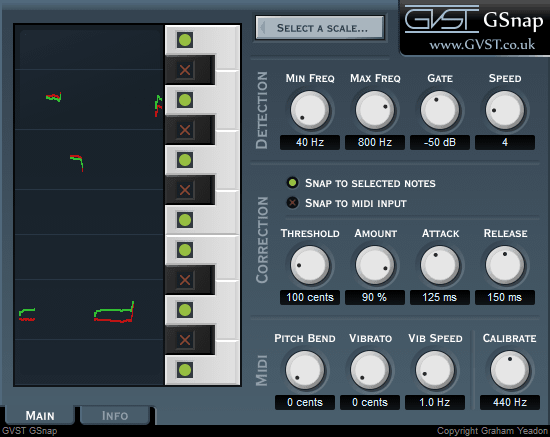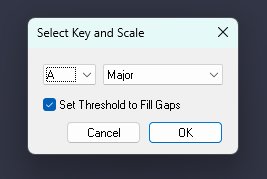GSnap Manual
Welcome to GSnap
GSnap is a free autotune effect for VST hosts.
It can be used subtly to correct the pitch of a vocal, or, with more extreme settings, to create a "robot voice" effect.
Gsnap will only work on monophonic input signals - that is, a melodic line rather than rhythm or chords.
In this case we're usually talking about the human voice, but the effect could be applied to other instruments.
Of course you can try it with any source material, but it's unlikely to have an desirable effect on non-melodic sounds, if it has any effect at all.
Interface

The GUI features 12 knobs which control all of the plug-in's parameters.
Each has its function clearly labelled above, and features a user-editable readout below.
Additionally, there are twelve "switches" positioned on the piano keyboard next to the pitch data view.
These switches correspond to the twelve semitones of a full octave in the Western chromatic scale,
and indicate which notes should be snapped to in the "fixed" mode of GSnap.
Two further switches allow the user to select between "fixed" or "midi" modes, explained below.
Many of the controls are divided amongst three groups: Detection, Correction, and MIDI.
The "Detection" section allows you to fine-tune how GSnap determines the pitch of the incoming audio.
The next section, "Correction", determines how GSnap will adjust the pitch to autotune the input.
Finally, the "MIDI" section relates to how GSnap deals with particular MIDI information when in MIDI mode.
To the left of the controls is a visual representation of the pitch of the source and "tuned" material.
The source material appears as a red line graph, and the tuned material a green one.
This can help the user zero in on problem notes, and also provide a secondary way (the primary being your ears!)
with which to gauge GSnap's effect on the source material.
Detection Controls
The incoming audio is first processed by this set of controls, which help give GSnap a bit of a break by
narrowing down the range of frequencies and sounds that the plug-in has to deal with.
Min Freq: Allows the user to set the minimum frequency, in Hertz, that GSnap will consider for correction.
If you know the lowest frequency that should be encountered, then setting this parameter can make pitch-detection more efficient and accurate.
Max Freq: This allows the user to set the highest frequency that will be considered for tuning.
As with "Min Freq", setting this can help the pitch-detection algorithm, making it more efficient and accurate.
(If in doubt you can just open the Min and Max Freq settings right up).
Gate: Any source material at a level below this setting is not considered for tuning.
You should aim to set this so that GSnap ignores background noise.
Speed: The Speed parameter sets the number of wave repetitions required for pitch-detection.
Lower values for Speed will allow faster pitch-detection but increase the chance of false detection.
Higher values will mean pitch-detection is more confident, but slower.
The default value should be fine in most cases.
Correction Controls
Once a pitch has been determined, GSnap applies pitch-correction according to these controls.
There are two modes of pitch correction: fixed scale and MIDI.
Fixed scale correction has a fixed set of snap-notes, while MIDI correction is controlled in real time by MIDI data.
Fixed Mode: When this mode is selected, notes are "snapped" to the notes selected on the piano keyboard.
If all notes are selected then pitches will be moved towards the nearest of the 12 chromatic notes.
Usually you'll want to select the notes corresponding to the key you're in or the specific notes in the phrase you're working on.
You can always check which notes are activated for snapping by looking at the piano keyboard and pitch display.
Select Scale:
(please note that this option may not be available in Mac and Linux ports, but it is just a shortcut for selecting notes on the keyboard).
Pressing the "Select Scale..." button brings up a dialog box:

A drop-down menu allows you to select the "root" of the scale, and another the "mode".
Checking the "Set Threshold..." option will automatically adjust the Threshold parameter so that the chosen scale is enforced fully,
without any gaps between the snap zones.
Midi Mode: When this option is selected, notes will snap to the nearest currently depressed MIDI note,
sent either by a controller being played in real-time, or by a pre-programmed MIDI sequence.
For this to work, your sequencer must be set up so that GSnap can receive both audio and MIDI messages.
Threshold: Defines the snapping region around each snap-note.
A "cent" is a percentage of a Western semitone.
For every 100 cents in the threshold, you add another semitone to the snapping region.
A higher threshold allows GSnap to catch a wider range of notes and push them towards the desired pitch,
although you can choose to leave gaps if you only want certain notes to be caught and corrected.
For standard scales, 100 cents would give full-coverage. With pentatonic scales, 150 cents are necessary.
You can always check the snap notes and zones on the pitch display.
In MIDI mode you might want to push the threshold right up so you can force any input to the note you play.
Amount: Sets the amount of correction that will be applied.
At 100% GSnap will push any note in a snap zone all the way to the correct, central pitch.
You might want to lower this to find a good compromise between pitch improvement and maintaining a natural sound.
Attack and Release: These parameters set how quickly a note reaches full correction and subsequently returns to no correction.
As a general rule, an extremely fast attack will produce a noticeable and distinctly artificial "snap", but may be necessary to deal
with certain phrases. Longer attack and release times can produce a more natural sound, but setting the times too long can also sound
unnatural or be ineffective, so exercise caution.
MIDI Controls
When the user has selected MIDI mode, these controls are used to set how GSnap will respond to incoming MIDI information.
Pitch Bend: Allows the user to set the maximum pitch bend.
Since every 100 cents represent a Western-scale semitone, the maximum bend at 200 cents is one full tone.
Vibrato: Defines the maximum range of the vibrato applied by manipulating the modulation
wheel or sending a mod wheel Continuous Controller (CC) message in a MIDI program.
Like Pitch Bend, its maximum range is 200 cents or one full tone.
Vib Speed: Represents the speed (in Hertz) of vibrato applied by MIDI when the user uses the modulation wheel or sends a modulation CC.
Calibrate
Calibrate: This control allows the user to calibrate the actual "tuning" of GSnap, with the number representing the frequency
of the note "A" in your song. This setting affects the detected note and consequently the amount of correction, regardless of the mode.
The default of A=440 Hz is the standard tuning calibration, and should be fine for the majority of situations.
However, there are exceptions, such as when singing to a track with a fixed instrument (e.g. a pipe organ) that is tuned to A=435.
Generally speaking, this should be left at 440 Hz unless you know that it should be something else.
Hints and ideas
-
Use the automatic correction with Forced Key to recreate the famous robotic, stepped vocal effect.
-
GSnap's effect is more useful with simple material.
Complex material with rapid note changes may require several hours of dedicated MIDI programming to deal with,
and may still end up sounding less than realistic.
-
Try GSnap with non-vocal material for interesting effects, but ideally.
-
If your DAW supports it, you can route a MIDI keyboard directly to GSnap and "play" the pitch-correction in real time.
-
You can get an interesting robot-harmony effect by duplicating a vocal line and using GSap MIDI mode to play harmonies on the second track.
-
If your DAW supports it, you can automate switching between Fixed and MIDI mode for ultimate control:
allow GSnap to do its thing automatically for much of the material, and then "take over" for passages or notes that need specific work.


